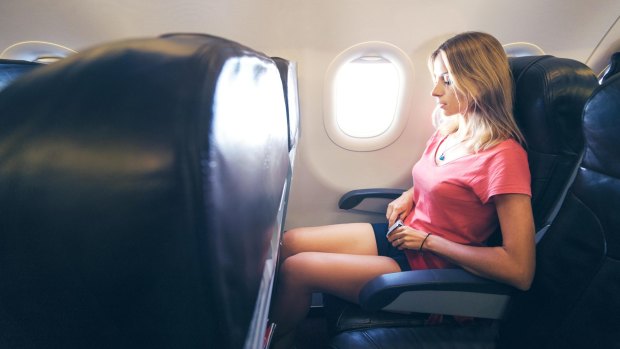By Michael Gebicki
Forget about the squish factor, it's also the way airline seats bend your back into a C-shape that makes sitting in them for extended periods such an ordeal.
Adding lumbar support puts the lower back in a more natural curve that offers far greater comfort for many.
Even something as simple as placing an airline pillow or a rolled blanket at the base of the seat back can provide relief, but not all airlines provide pillows or blankets, especially those operating on short routes.

Sitting in an airline seat for an extended period can be an ordeal.Credit: Shutterstock
Contoured foam or bead-filled travel pillows are one solution but they're bulky.
Blow-up pillows, such as the Therm-a-Rest Lumbar Travel Pillow, which self inflates simply by opening a valve, weigh little and compress when deflated, are a good compromise.
The other area that suffers is the neck, which is often unsupported when you sleep in your seat, causing pain.
A supportive neck pillow is the solution and these come in many permutations but one that wraps completely around the neck to stop it from flopping around works well for most flyers.
Was flying better 50 years ago?
Tempting as it is to view the past through rose-tinted eyewear, that's not the whole picture. Back in the late 1960s aircraft cabins were noisier due to louder engines. Smoking was permitted, and everyone became a passive smoker thanks to the fumes washing through the cabin via the air-conditioning system. If there was an entertainment system it might have been a movie not of your choice screened on one of several overhead CRT screens.
Air travel back in 1968 also cost far more in real terms than today. On the upside, seat pitch in economy class was generally five centimetres greater than today and seats were slightly wider on average. Aircraft flew with far fewer seats filled, which contributed to the feeling of spaciousness. One of the biggest differences is us.
Back in the 1960s the average Australian adult male weighed 74 kilograms. Today that figure is 86 kilograms. Average adult weight for women was 64 kilograms, today it's 71. Most of that extra weight has caused our middles to balloon, and so it's no surprise we're feeling squashed.
The best economy class (according to the 2018 World Airline Awards)
(click on the links for Traveller's reviews of these airlines)
- Thai Airways (Review: A350 economy class)
- Singapore Airlines (Review: A380 economy class)
- Qatar Airways (Review: Airbus A330 economy class)
- Emirates (Review: A380 economy class)
- ANA All Nippon Airways (Review: ANA Dreamliner economy class)
- Cathay Pacific Airways (Review: A350 economy class)
- Garuda Indonesia (Review: A330 economy class)
- EVA Air
- Lufthansa (Review: A380 economy class)
- Japan Airlines
See also: The perfect economy seat (with one exception)
See also: Why plane seats don't face backwards
Sign up for the Traveller newsletter
The latest travel news, tips and inspiration delivered to your inbox. Sign up now.